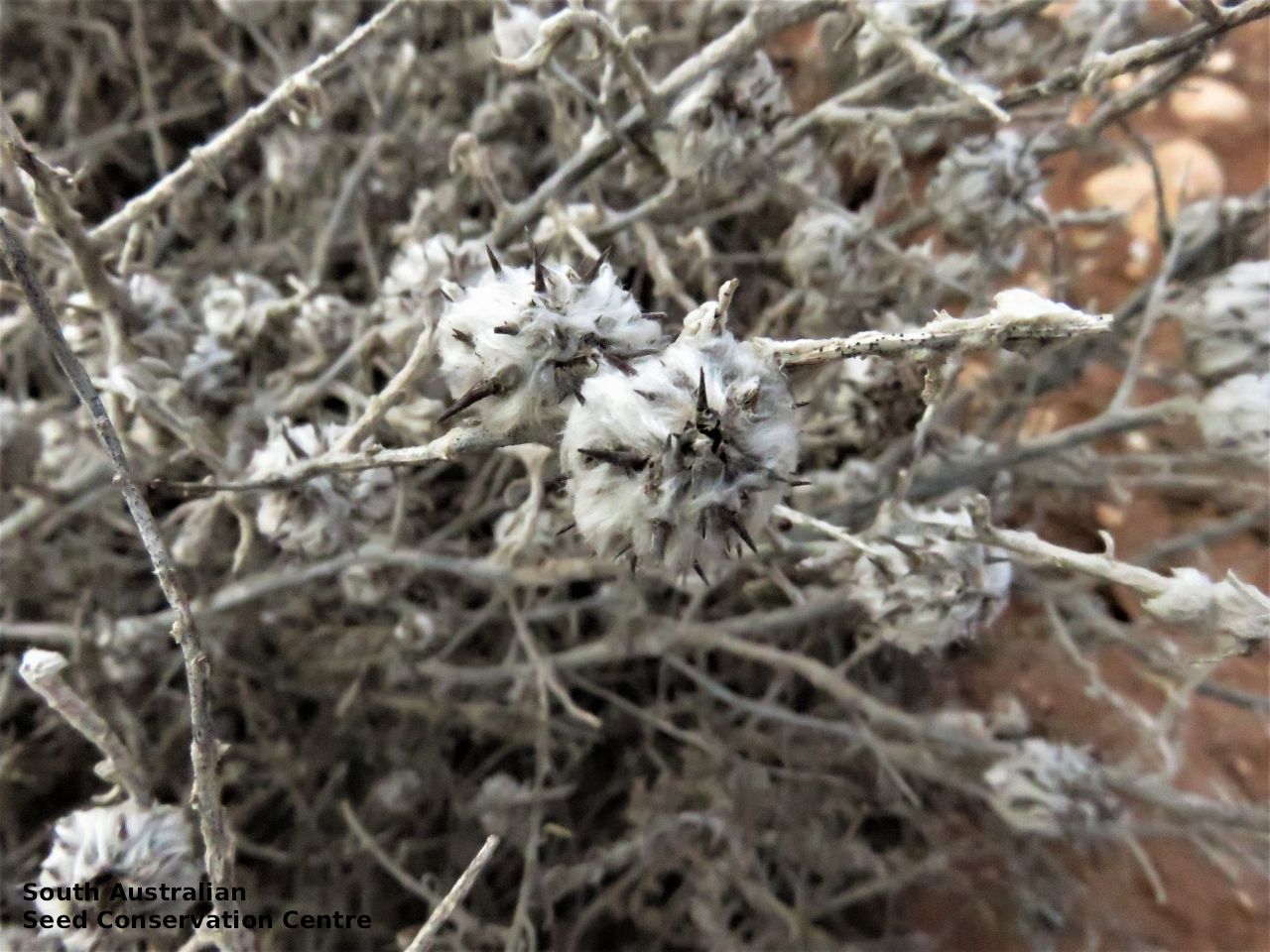Cannonball Burr,
Ball Bindyi,
Hard-head Saltbush
Display all 22 images






















Regional Species Conservation Assessments per IBRA subregion.


Least concern
Near threatened
Rare
Vulnerable
Endangered
Critically endangered
Extinct
Data deficient
Adelaide
Arkaroola
Ceduna
Coober Pedy
Hawker
Innamincka
Marla
Marree
Mount Gambier
Oodnadatta
Renmark
Wudinna
Keith
Yunta
Display IBRA region text
| Olary Spur (FLB03) | Flinders Lofty Block | Least Concern (Definite Increase) [likes disturbed areas] |
| Southern Flinders (FLB04) | | Least Concern (Definite Increase) [likes disturbed areas] |
| Northern Flinders (FLB05) | | Least Concern [prickly] |
| Central Flinders (FLB06) | | Least Concern [prickly] |
| St Vincent (EYB02) | Eyre Yorke Block | Least Concern (Definite Increase) [likes disturbed areas] |
| Eyre Hills (EYB03) | | Rare (IUCN: RA d(ii)) [edge of range] |
| South Olary Plain (MDD01) | Murray Darling Depression | Least Concern (Probable Increase) [not grazed] |
| Murray Mallee (MDD02) | | Least Concern (Probable Increase) [not grazed] |
| Braemer (MDD07) | | Least Concern (Definite Increase) [likes disturbed areas] |
| Murray Scroll Belt (RIV06) | Riverina | Least Concern (Probable Increase) [not grazed] |
| Myall Plains (GAW01) | Gawler | Least Concern |
| Gawler Volcanics (GAW02) | | Least Concern |
| Gawler Lakes (GAW03) | | Least Concern |
| Arcoona Plateau (GAW04) | | Least Concern |
| Kingoonya (GAW05) | | Least Concern |
| Torrens (GAW06) | | Least Concern |
| Roxby (GAW07) | | Least Concern |
| Commonwealth Hill (GAW08) | | Least Concern |
| Maralinga (GVD03) | Great Victoria Desert | Near Threatened |
| Kintore (GVD04) | | Least Concern |
| Tallaringa (GVD05) | | Least Concern |
| Yellabinna (GVD06) | | Near Threatened |
| Nullarbor Plain (NUL02) | Nullarbor | Near Threatened |
| Barrier Range (BHC01) | Broken Hill Complex | Least Concern (Definite Increase) [likes disturbed areas] |
| Barrier Range Outwash (BHC04) | | Least Concern (Definite Increase) [likes disturbed areas] |
| Bimbowrie (BHC05) | | Least Concern (Definite Increase) [likes disturbed areas] |
| Curnamona (BHC06) | | Least Concern (Definite Increase) [likes disturbed areas] |
| Simpson Desert (SSD02) | Simpson Strzelecki Dunefields | Least Concern [prickly] |
| Dieri (SSD03) | | Least Concern [prickly] |
| Warriner (SSD04) | | Least Concern |
| Strzelecki Desert (SSD05) | | Least Concern [prickly] |
| Breakaways (STP01) | Stony Plains | Least Concern |
| Oodnadatta (STP02) | | Least Concern |
| Murnpeowie (STP03) | | Least Concern |
| Macumba (STP05) | | Least Concern |
| Witjira (STP06) | | Least Concern |
| Baltana (STP07) | | Least Concern |
| Sturt Stony Desert (CHC02) | Channel Country | Least Concern |
| Coongie (CHC06) | | Least Concern |
| Lake Pure (CHC07) | | Least Concern |
| Mann-Musgrave Block (CER01) | Central Ranges | Least Concern |
| Everard Block (CER03) | | Least Concern |
| Tieyon (FIN03) | Finke | Least Concern |
| Pedirka (FIN04) | | Least Concern |
| 4 of 6 subregions | Flinders Lofty Block | Least Concern |
| 2 of 5 subregions | Eyre Yorke Block | Least Concern , Rare |
| 3 of 6 subregions | Murray Darling Depression | Least Concern |
| Murray Scroll Belt (RIV06) | Riverina | Least Concern (Probable Increase) [not grazed] |
| 8 of 8 subregions | Gawler | Least Concern |
| 4 of 4 subregions | Great Victoria Desert | Least Concern , Near Threatened |
| Nullarbor Plain (NUL02) | Nullarbor | Near Threatened |
| 4 of 4 subregions | Broken Hill Complex | Least Concern |
| 4 of 4 subregions | Simpson Strzelecki Dunefields | Least Concern |
| 6 of 7 subregions | Stony Plains | Least Concern |
| 3 of 4 subregions | Channel Country | Least Concern |
| 2 of 3 subregions | Central Ranges | Least Concern |
| 2 of 2 subregions | Finke | Least Concern |
Botanical art
Kath Alcock paintings: 7
Prior names
Sclerolaena paradoxa
Bassia paradoxa
Common names
Cannonball Burr
Ball Bindyi
Hard-head Saltbush
Etymology
Dissocarpus from the Greek 'dissos' meaning two fold and 'carpos' meaning fruit, referring to the paired fruits of the original species. Paradoxus from Latin meaning contrary to the usual type, anomalous.
Distribution and status
Found across the northern part of South Australia, growing on clay or on scalded zones. Also found in all mainland states. Native. Common in South Australia. Common in the other states.
Herbarium regions: North Western, Lake Eyre, Nullarbor, Gairdner-Torrens, Flinders Ranges, Eastern, Eyre Peninsula, Northern Lofty, Murray
NRM regions: Alinytjara Wilurara, Eyre Peninsula, Northern and Yorke, South Australian Arid Lands, South Australian Murray-Darling Basin
AVH map: SA distribution map (external link)
Plant description
Annual or short lived perennial erect or decumbent shrub to 50 cm high with woolly branches. Leaves semiterete, slender, to 15 mm long, densely white woolly. Flowers 8-16, united into woolly spherical axillary clusters. Flower throughout the year. Fruits are woolly, burr-like fruit to 15 mm diameter, woody in the central part, covered in hooked spines. Seed embryo type is peripheral
Seed collection and propagation
Collect seeds between January and December. Collect fruit that are large, hard and turning brown. Be careful as the fruits are spiny. Place the fruits in a tray and leave to dry for 1-2 weeks. No further cleaning is required if only the fruits are collected. Store the dried fruit heads with a desiccant such as dried silica beads or dry rice, in an air tight container in a cool and dry place. Germination 89%, seed scarified (covering structure removed) on 1% w/v agar, 16/8 dark/light, 200C. See http://data.kew.org/sid
Germination table:
Display





















